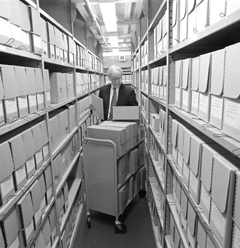The University Record, November 1, 1999 By Joanne Nesbit
News and Information Service

It took an escorted convoy of nine moving vans in 1977 to get the material from Washington, D.C., to a warehouse on East Hoover. Now the television game show “Jeopardy” calls to verify questions and answers. In the past 12 months, nearly 4,000 individuals have made inquiries via telephone, letter and e-mail. Another 200,000 have visited the Web site. And 39,861 pages of historical material have been photocopied by on-site and off-site researchers.
“Though Gerald R. Ford’s presidency ran only two-and-a-half years,” says David Horrocks, chief archivist of the Gerald R. Ford Library on North Campus, “the White House papers accumulated during that time equal all the papers of Franklin D. Roosevelt’s three-plus terms that encompassed the Great Depression and World War II.”
The collection, housed since 1980 in the Ford Library, exists largely to serve the needs of researchers today and in future years, says Horrocks. The Library currently holds 20 million documents and one-half million audiovisual items.
Ford wanted his papers, owned by the American people, to be located at the U-M, his alma mater. An agreement was worked out whereby the U-M would build an archival facility and give the federal government free and perpetual use of it, making it a part of the presidential libraries system run by the National Archives and Records Administration. The U-M provided the land and $4.3 million in private donations funded a structure of 35,700 “occupiable” square feet.
Archivists at the Library are federal employees. “Typically,” Horrocks says, “a Ford Library archivist has a graduate degree in history or a master of library studies, plus extensive coursework in history. Almost all have completed the National Archives’ formal two-year training program, and a few have additionally undertaken university course work in archives administration.”
Materials available for researchers range from minutes of staff meetings to campaign strategy plans. The Presidential Handwriting File (annotated memos, etc.) alone fills more than 20 feet of shelf space.
Besides organizing the materials for research use, the Library staff also is responsible for most of the declassification of materials once noted as “sensitive.”
“Declassification work is intellectually complex, technically rigorous and personally stressful,” Horrocks says. “The archivists must have real subject expertise and superb judgement.”
The latest declassification work at the Library involves about 40,000 pages of classified material on the Vietnam War, especially its final years and immediate aftermath. The material, to be released in April, will include files from such collections as Memoranda of Presidential Conversations, National Security Advisor’s Backchannel Messages, Presidential Country Files, National Security Council Staff Country Files, and National Security Council Staff Intelligence and Other Reports on Vietnam.
In addition to television game shows, authors and the general public, U-M students and faculty use the Library as a resource. History Prof. Rebecca Scott’s freshman/sophomore seminar “Cuba and the United States: Ties of Singular Intimacy” involved student examination of recently declassified files on U.S. covert operations against Cuba in the 1960s.
The Gerald R. Ford Presidential Library is located at 1000 Beal Ave. and is open 8:45 a.m.–4:45 p.m. Monday–Friday. The Library is closed on federal holidays. Additional information about the Ford Library and its holdings is on the Web at www.ford.utexas.edu/.

